#quaternary extinction
Text

Neolicaphrium recens here might look like some sort of early horse, but this little mammal was actually something else entirely.
Known from southern South America during the late Pleistocene to early Holocene, between about 1 million and 11,000 years ago, Neolicaphrium was the last known member of the proterotheriids, a group of South American native ungulates that were only very distantly related to horses, tapirs, and rhinos. Instead these animals evolved their remarkably horse-like body plan completely independently, adapting for high-speed running with a single weight-bearing hoof on each foot.
Neolicaphrium was a mid-sized proterotheriid, standing around 45cm tall at the shoulder (~1'6"), and unlike some of its more specialized relatives it still had two small vestigial toes on each foot along with its main hoof. Tooth microwear studies suggest it had a browsing diet, mainly feeding on soft leaves, stems, and buds in its savannah woodland habitat.
It was one of the few South American native ungulates to survive through the Great American Biotic Interchange, when the formation of the Isthmus of Panama allowed North and South American animals to disperse into each other's native ranges. While many of its relatives had already gone extinct in the wake of the massive ecological changes this caused, Neolicaphrium seems to have been enough of a generalist to hold on, living alongside a fairly modern-looking selection of northern immigrant mammals such as deer, peccaries, tapirs, foxes, jaguars… and also actual horses.
Some of the earliest human inhabitants of South America would have seen Neolicaphirum alive before its extinction. We don't know whether they had any direct impact on its disappearance – but since the horses it lived alongside were hunted by humans and also went extinct, it's possible that a combination of shifting climate and hunting pressure pushed the last of the little not-horses over the edge, too.
———
NixIllustration.com | Tumblr | Twitter | Patreon
#science illustration#paleontology#paleoart#palaeoblr#neolicaphrium#proterotheriidae#litopterna#meridiungulata#south american native ungulates#panperissodactyla#ungulate#mammal#art#convergent evolution#not-horse#a phony pony#quaternary extinction
478 notes
·
View notes
Text
also. late quaternary extinction of a tree species in Eastern North America.
I've posted a little bit in the past about end-pleistocene megafauna extinctions, the overkill hypothesis, and the impact on "humans are the virus" type interpretations of ecology. This tree is the only documented end-Pleistocene plant extinction, which seems really striking, but this paper (from 1999) is like "yeah we haven't really studied it, and pollen deposits don't really allow for distinguishing plants on the species level, and most macrofossil sites have barely been analyzed."
I tried to do some research on end-pleistocene palynology in the USA and found this paper, which if anything gives a decent glimpse into what palynology does and doesn't allow us to analyze, and it is noted that "Nyssa, however, is distinctly entomophilous (Smiley Apiaries 2014), so just about any amount of its pollen in a sample suggests that the plants grew quite close to the site of deposition, where the discarded flowers accumulated. Because Nyssa is exclusively a freshwater entomophilous genus, the presence of its pollen in any significant quantity (>1%, F.J. Rich, personal observation) marks the site of a former freshwater wetland"
In other words, "Nyssa (blackgum) is insect pollinated, so its seriously weird that its pollen shows up in this fossil pollen sample, and would have to mean that there was a big grove of them with flowers falling to the ground right where the sample was collected."
Most of the species detected in this study are wind-pollinated species that are mega abundant and produce shit tons of airborne pollen, and they are identifiable down to either genus or family level. This means we can't say much about plants pollinated by insects, plants that were a small part of the total plants in the area, or plants that differed from modern ones only on species level.
Which means that it's misleading to say "there was only one End-Pleistocene plant extinction in USA" because we couldn't know that either way!
In fact the presence of plants like Torreya, Franklinia, and other "relict" plants along the Gulf Coast with ultra tiny ranges that likely used to be more widespread suggests that tons of plants could have gone extinct during the Last Glacial Maximum, since all it would take is a plant being 5% more intolerant to the glaciated climate than any of the numerous plants that got severely bottlenecked
It seems like the plants haven't gotten as much attention in research and that keeps being interpreted as "nah, there wasn't really an effect on the plants, only animals went extinct mostly" NO!!!!
178 notes
·
View notes
Text
Quaternary includes both the Pleistocene and Holocene extinction pulses, even though the first may not be entirely anthropogenic
I’m not including the great oxygenation event because that is the least clear in terms of whether or not it actually was an extinction
541 notes
·
View notes
Text

The open oceans of the future would vastly resemble those of today, with similar groups dominating the seas. The biggest and most dominant animals are the cetaceans, descended from two single surviving species: the Commerson’s dolphin and the Guyana dolphin.
Some of the biggest dolphins are the macropredatory Cetovenatoridae, and some enormous bottom feeders, like the muckwhale. Other effective predators are the deep hunting tribune whales, the pod hunting spotted seadogs, and the school targeting Atlantic blue dolphins.
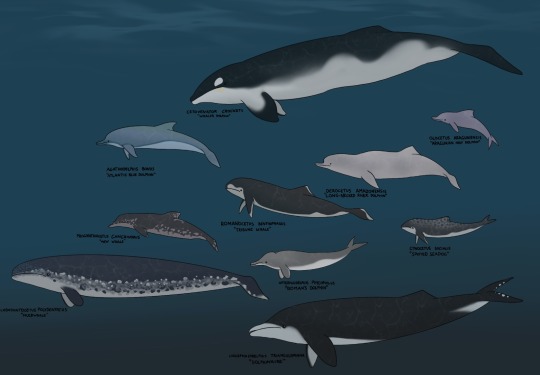
Since seals and other pinnipeds went completely extinct at the end of the Holocene their niche will be filled by the Phutroidea superfamily ( https://www.reddit.com/r/SpeculativeEvolution/s/ljdSwyAmat ), descended from marine otters.
Pelagic fish niches remained mostly unchanged, with most sharks, rays and teleost taxa surviving the mass extinction.

In the Anectyocene oceans, tho, there’s also new additions: a group of ancestrally oceanic platypuses, with a handful of secundarily freshwater Asian and South Pacific species, that feed on invertebrates on the seafloor; and sea sloths descended from three-toed sloths, converging on Thalassocnus’s lifestyle, pulling themselves across the seafloor grazing seaweed, and becoming the biggest sloths since the Quaternary.
#spec evo#spec bio#speculative evolution#speculative biology#artwork#digital art#epigene period#future earth
25 notes
·
View notes
Text




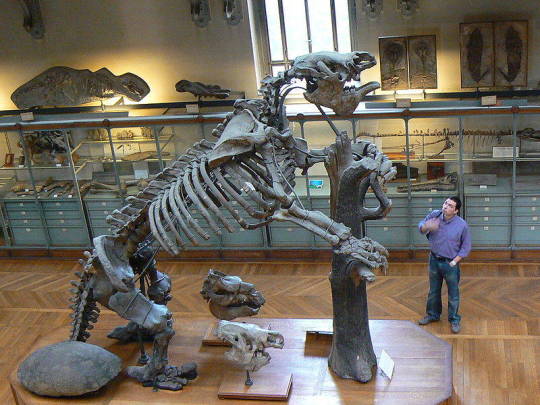
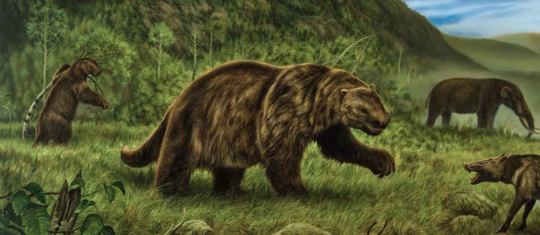


Megatherium known as the giant ground sloth or the megathere is an extinct genus of ground sloth which lived throughout South America from the Pliocene to Pleistocene some 5 million to 12,000 years ago. The first known remains of Megatherium consisting of a mostly complete skeleton were discovered in 1788 by Manuel Torres, on the bank of the Luján River in Argentina. The fossil was shipped to Museo Nacional de Ciencias Naturales in Madrid the following year, where it remains. It was reassembled by museum employee Juan Bautista Bru in 1795 and subsequently described by Georges Cuvier in 1796. Cuvier assigned the fossil the scientific name Megatherium americanum from the Greek méga 'great' and theríon 'beast' and americanum being a reference to the Americas. In the centuries to follow dozens of well preserved specimens have been recovered representing some 8 species considered valid: M. americanum, M. altiplanicum, M. gallardoi, M. istilarti, M. medinae, M. parodii, and M. sundti which are separated into the two sub-genuses of Megatherium and Pseudomegatherium. With the largest species reaching some 20ft (6m) in length, 7ft (2.1m) tall when on all fours, and 8,400 to 10,100lbs (3,810 to 4580kgs) in weight, megatherium surpassed most modern elephants in size making it not only one of the largest xenathrans but one of the largest mammals known to have ever existed. Megatherium had a robust skeleton with a large pelvic girdle and a broad muscular tail. Its large size enabled it to feed at heights unreachable by other contemporary herbivores. Rising on its powerful hind legs and using its tail to form a tripod, Megatherium could support its massive body weight while using the curved claws on its long forelegs to pull down branches. These large animals likely lived in small groups feeding during the day before spending there nights resting inside of caves and large burrows the animals likely dug using there massive claws. Megatherium became extinct around 12,000 years ago during the Quaternary extinction event, which also claimed most other large mammals throughout the world. The extinction coincides with the settlement of the Americas, and multiple kill sites where M. americanum was slaughtered and butchered, suggesting that human hunting helped caused the sloths extinction.
Art belongs to the following creators:
Megatherium Mother and Baby: Mark Witton
https://www.redbubble.com/i/art-board-print/Megatherium-by-MarkWitton/40411556.TR477
Megatherium: Brian Engh
Lost World - Megatherium: Rob Brunette
https://www.artstation.com/artwork/3dbQXY
#pleistocene pride#pleistocene#pliestocene pride#pliestocene#cenozoic#ice age#stone age#giant sloth#sloth#ground sloth#giant ground sloth#megatherium#pliocene#south america#megafauna#prehistoric#prehistoric animals
13 notes
·
View notes
Photo

A review of the late Cenozoic genus Bohra (Diprotodontia: Macropodidae) and the evolution of tree-kangaroos
GAVIN J. PRIDEAUX, NATALIE M. WARBURTON
Abstract
Tree-kangaroos of the genus Dendrolagus occupy forest habitats of New Guinea and extreme northeastern Australia, but their evolutionary history is poorly known.
Descriptions in the 2000s of near-complete Pleistocene skeletons belonging to larger-bodied species in the now-extinct genus Bohra broadened our understanding of morphological variation in the group and have since helped us to identify unassigned fossils in museum collections, as well as to reassign species previously placed in other genera.
Here we describe these fossils and analyse tree-kangaroo systematics via comparative osteology. Including B. planei sp. nov., B. bandharr comb. nov. and B. bila comb. nov., we recognise the existence of at least seven late Cenozoic species of Bohra, with a maximum of three in any one assemblage.
All tree-kangaroos (Dendrolagina subtribe nov.) exhibit skeletal adaptations reflective of greater joint flexibility and manoeuvrability, particularly in the hindlimb, compared with other macropodids. The Pliocene species of Bohra retained the stepped calcaneocuboid articulation characteristic of ground-dwelling macropodids, but this became smoothed to allow greater hindfoot rotation in the later species of Bohra and in Dendrolagus.
Tree-kangaroo diversification may have been tied to the expansion of forest habitats in the early Pliocene. Following the onset of late Pliocene aridity, some tree-kangaroo species took advantage of the consequent spread of more open habitats, becoming among the largest late Cenozoic tree-dwellers on the continent. Arboreal Old World primates and late Quaternary lemurs may be the closest ecological analogues to the species of Bohra.
Read the paper here:
https://mapress.com/zt/article/view/zootaxa.5299.1.1
23 notes
·
View notes
Text
An extinct deep-snouted Alligator species from the Quaternary of Thailand and comments on the evolution of crushing dentition in alligatorids
Published 13th July 2023
Description of a newly identified species of extinct alligator from the Quaternary of Thailand, Alligator munensis, based on a well preserved skull.
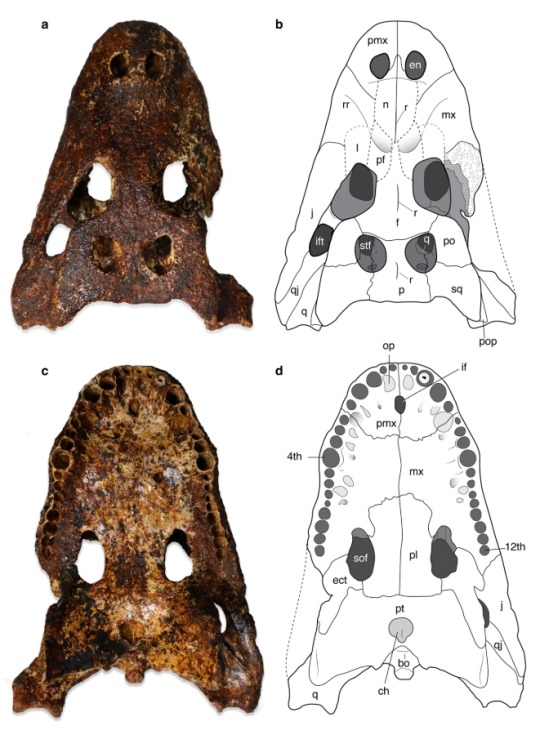
Dorsal and ventral views of the Alligator munensis holotype
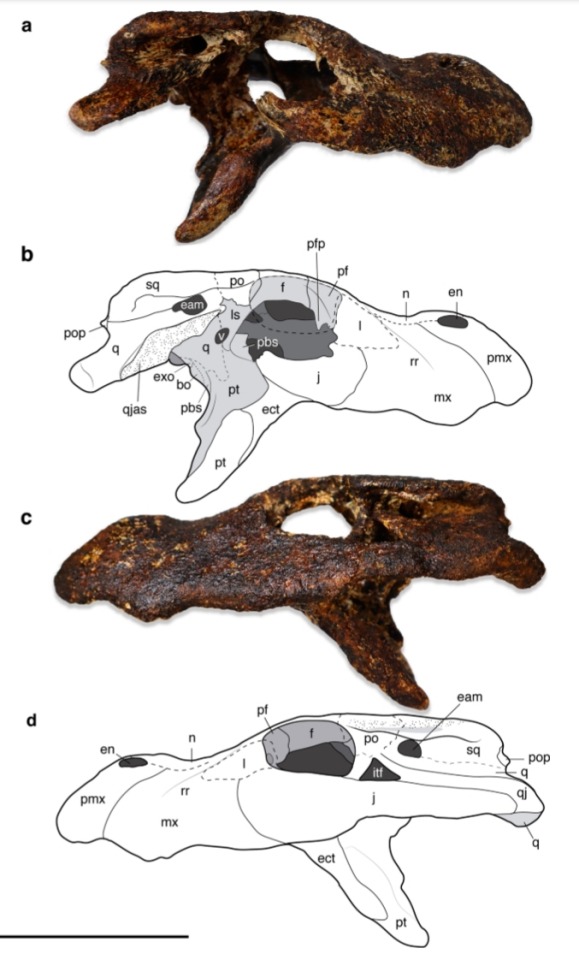
lateral views of the Alligator munensis holotype

Alligator munensis holotype, Alligator mississippiensis (American alligator) and Alligator sinensis (chinese alligator) skulls compared

reconstruction of Alligator munensis, Art by Márton Szabó
Digital 3D model of Alligator munensis holotype:
https://www.morphosource.org/concern/media/000490374
Source:
9 notes
·
View notes
Text
last final today everybody think of me and send me luck. read more is just my review session. don't really suggest opening but you know. raahhhh...
hadaen - archean - proterozoic (ediacambrian) - phanerozoic (paleozoic, mesozoic, cenozoic)
paleozoic - cambrian (explosion), ordovician (end extinction), silurian, devonian (late extinction), carboniferous, permian (end extinction)
mesozoic - triassic (end extinction) jurassic cretaceous (end extinction). of course
cenozoic - paleogene neogene quaternary
WAAHHHH.
permian - Pangaea Connected. woww synapsids evolve to large size & dominant roles! (amniotes w laterotemporal fenestrae) reptiles! ... errgggh.. Dimetrodon. Gorgonopsids. Dicynodon. Cynodon (would evolve into true mammals!).
end permian mass extinction. synapsids go OUGH! WAAAHH!!
triassic - synapsids dicynodon/cynodon rebound. first true mammals appearing.
Diapsids (fenestrae lateral + supratemporal) are evolving. like woah who is she ? Girl thats an archosaur.! diapsids who have Additional fenestrae — antorbital (in feont of orbits) and Mandibular (rear of lower jaw)! one key one to remember is the pseudosuchians who would later give rise to modern crocodilians . the other diapsid that Doesnt have additional fenestra is the. lepidosauromorph...
oldest record of dinosaur-like archosaurs from footprints ~250million years old
- small, bipedal, lacked specializations like true dinosauria (hip socket with hole)
- → dinosauromorphs (some were quadrupedal)
fuck me. ok. pterosaurs. archosaur. avemetatarsalian (ankle like a hinge rather than ball and socket). rhamphorphcynoids. wings w 1 elongated finger. first flying vertebrate yaayy
ichthyosaur - reptile. fish like lifestyle. paddle-like limbs finned tail shark like dorsal fin conical teeth etc. plesiosaur. another reptile. large test/torso, paddle limbs, rel. short tail. ok.
dinosaurs across the world from early triassic - early jurassic r fairly similar bc. pangaea.
first true sauropods (herbivorous quadrupedal saurischian) appear Late triassic with prosauropods but eventually overtake them. examples?! diplodocids and macronarians. diplodocid nipping peg-like teeth macronarians Ermm. munching teeth. less picky.
ornithischian thyreophorans appear. include ornithischian w armour e.g. stegosaurus (stegosaurus mainly known for jurassic)
I dont know where the fuck this goes. TRIASSIC END EXTINCTION!
it hit who?! Really hit the archosaurs but not the dinosaurs..?! both pseudosuchians and dinosaurs were well adapted — dinosaurs got lucky with some biological aspect that made them better able to survive the end-triassic extinction. woah!
anyway. predator wise. .... wuaw. megalosaurids and cretasaurids (theropods) but Late Jurassic had predator shift. To What? allosauroids and coelurosaurs!
allosauroids - vertebrae interlocked more rigid + proportionately longer legs
coelurosaurs - ..small. e.g. compsognathus. long series of sacral vertebrae, skinny light tail etc. would give rise to...?! Birds (first evolved late jurassic I am assuming this refers to the archaeopteryx which as found by hexley is the missing link between dinosaurs and modern birds and falls in the Avialae clade) and Tyrannosaurs! Woah!
early cretaceous has significant regional dinosaur differences. unfortunately i do not remember them! Early cretaceous is genuine fucking blur to me!! copy pasted from notes
- NA + europe: iguanodontians, ankylosaurs, brachiosaurid sauropods
- africa: dominant theropods were spinosaurs and carcharodontosaurids
- asia: coelurosaurian theropods became common, first ceratopsians evolved
erm. new theropods like spinosaurids + carcharodontosaurids, iguanodons become larger and abundant. mosasaur (reptile). bye stegosaurs (rare) hello ankylosaurs. also diplodocids go extinct. SAUROPOD DECLINE!
LATE CRETACEOUS! shit is going down.
sauropod decline but Thriving in...?! Southern supercontinent GONDWANA! but they're different from before.. 🤔 it's the Titanosaurs! most robust of All time! for example the argentinosaur the largest animal to have ever lived. also many had armour.
size and armour who could combat them... the Carcharodontosaurs! teeth like great white shark. may be an allosaurus. i think. there were also the ...! abelisaurs! last of the ceratosaurid lineage. short muzzle Short arms Small teeth this guy would go after the Smaller titanosaurs.
But what was happening in Northern supercontinent Laurasia 🤔 well the sauropod decline really hit here. so if there's an underabundance of herbivorous sauropods who is eating the fucking plants (which also differ from gondwana bc of such underabundance)
. replacing the iguanodons is the HADROSAURS! most successful herbivorous dinosaur in the northern hemisphere congratulations. two examples?! lambeosaurine which had a hollow nasal passageway in its crest (music. mating? scaring off?) and hadrosaurines which did not have that. at least some had crests just not from osteoderms. soft tissue?!
second to them is the Ankylosaurs which diverge into two main groups: tail club having ankylosaurids and No club nodosaurids. i remember bc. nodo. no dough? No money. for. ....the cl... the clu
Also second to them. marginocephalians — "fringe head" pachycephalosaurs and ceratopsians. primitive ceratopsians well known in asia but larger derived ones almost exclusive to north america.
And what is happening in laurasia Predator wise 🤔 allosaurs are doing well but they have competition: Its the Coelurosaurs! WOAHHHH!!!
tyrannasaurs, ornithomimids, maniraptorans - oviraptorosaurs + therizinosaurs + dromaeosaurs. maniraptorans had the semilunate carpal that let them sharply fold back their hands. good for u. therizinosaurs are different. theyre freaky little guys /affectionate. their claw was found first and people thought it was a claw of a sea turtle. Alas.! it was this weird dude
dinosaur rise to power was slow, steady, and pushed by misfortune of others
CRETACEOUS END EXTINCTION! grey layer at cretaceous-paleogene border found w iridium tektite and shocked quartz which r all signs of meteorite impact... Where?!
big meteor hit shore of chicxulub mexico (found by odd formation of limestone sinkholes called cenotes). shockwaves tsunamis cloud of super heated rock and dust falls causing wildfires and raised temperatures so large animals without shelter Like dinosaurs die. and then they dont get the sun for years so photosynthetic organisms and plants die. dinosaurs at the top of the food chain go goodbye :(
and despite all of this i feel so incredibly underprepared for this exam because specific details and examples haunt me. if he asks to pick a list of archosaurs i'll start biting my hand. its fine. aim for a 75. am i right guys. guys. like its multiple choice so im just praying i remember. enough. ...??? it's over for me
#💬nia.rambles#i still have to finish my essay afterward. but. exam wise. RAAAHHH#and then i am free to write whatevah i want... Woahhh..#goal is to go through all my wips/reqs before the year ends. Hah....#this will be my month. ...my last half of a month.
6 notes
·
View notes
Text
love the Zelda lore of the calamity happening 10,000 years ago but only in modern day totk did we get cheese invented
like 10,000 irl years ago the mammoth just died out imagine waiting until today to figire out cheese lol
so yes that's why everyone is like 'oh it's a legend the calamity is a fairytale' because that's like telling kids now about the quaternary extinction and how we were JUST figuring out how to domesticate cattle at that time. the oldest cheese ever found was only 3200 years old.
5 notes
·
View notes
Text
Primary cause of death: Gemma (worst coworker)
Secondary cause of death: Asphyxiation (total)
Tertiary cause of death: Lack of oxygenated blood flow to brain (stem)
Quaternary cause of death: Holding breath for eleven continuous minutes (too long)
Quinary cause of death: Refusal to let Gemma win (again)
Senary cause of death: Desperate implementation of inadvisable argument-winning tactic (childish)
Septenary cause of death: Gemma’s opinions (terrible)
Octonary cause of death: Argument about dinosaurs (extinct reptile clade)
Nonary cause of death: Not learning lesson after first argument with Gemma (pointless; also not dinosaur-related)
Denary cause of death: Gemma’s ability to taunt, mock, berate, etc. without stumbling over her words (infuriating)
Undenary cause of death: Gemma’s habit of starting arguments with anyone who disagrees with her (approx. entire population of Earth, save Gemma)
Duodenary cause of death: Own inability to argue without crying (snot involved)
Dinosaurs’ primary cause of death: Asteroid (unexpected)
Tredenary cause of death: Weaker-than-average blood circulation (Vitamin D deficiency)
Quadrodenary cause of death: Lifelong aversion towards liver, oily fish, mushrooms, egg whites, and other Vitamin D-rich foods (oranges okay though)
Quindenary cause of death: Gemma’s wilful distrust of even basic scientific mainstays (e.g. evidence-based claims)
Sexadenary cause of death: Mounting irritation at lunches, including occasional orange, persistently missing from break room fridge (primary suspect - Gemma; secondary suspect - not stolen, just keep forgetting them at home)
Septendenary cause of death: Remembering, while in dizzy, hungry, tearful mid-argument over whether or not dinosaurs were wiped out because, quote “obviously they must have all eaten each other, duh”, old childhood tactic of holding breath until other party admits defeat (# of successful attempts: still 0)
Dinosaurs’ secondary cause of death: Bad luck (sheer)
2 notes
·
View notes
Text
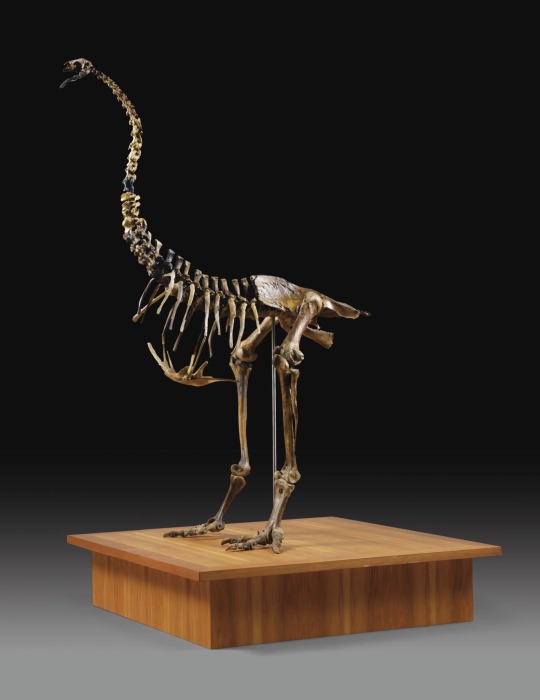
Rare and exceptional complete Moa skeleton, Megalapteryx didinus (Owen 1883); Sub-recent Quaternary; Canterbury, New Zealand.
This bird is part of the Dinornithiformes, an ancient order including a group of missing birds that did not fly. The species making up this order are called Moas. They are fossil birds that moved to the ground and were, because of their large size (sometimes up to 3 meters), unfit for flight. The different Moas are extinct species. These large birds being herbivorous, they were docile in nature and therefore easily huntable. As a result, the Moa disappeared around the year 1400, 400 years after the Maori arrived on the New Zealand archipelago, along with its fabulous predator the Haast Giant Eagle. Both species must also suffer from the inexorable mechanism of burns that gradually destroys and nibbles the environment.
Sotheby’s
15 notes
·
View notes
Text
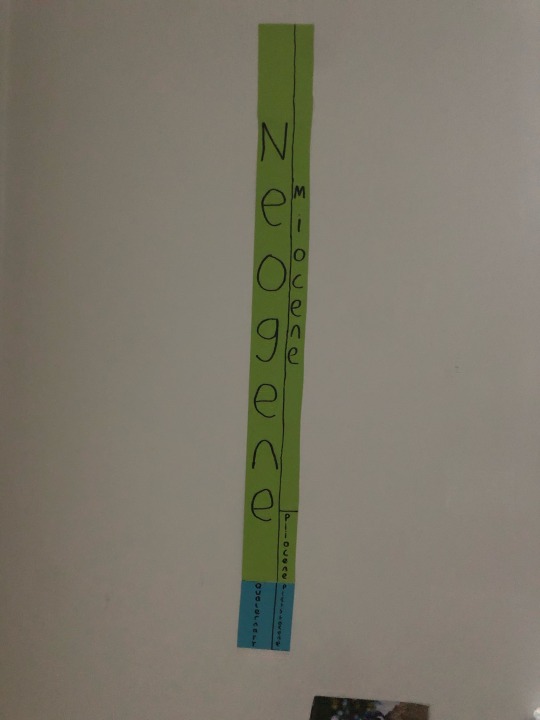
I recently moved, and an idea for decorating my new apartment has been gnawing on my mind ever since: a timeline of natural history with a bunch of paleoart around it running all the way around the walls of my home. Today I took the first steps in making the timeline itself, which is sort of gonna be like the skeleton of the whole piece. I made the Quaternary and the Neogene! At a scale of a million years per three centimetres, the Holocene is a barely visible pen line 0.4 mm thick at the bottom, while the full timeline will be 19.4 metres long and run all the way to the late Cryogenian. After this initial vertical bit, it's going to bend to the left, wrap all the way around my living room, through the hall, and into the bedroom, going halfway around it before ending at the bedroom window. The K-Pg extinction will be right above my desk chair, the Triassic over my bookcases, the Carboniferous will be split in three pieces by the hall, and my bed will be surrounded by the Ediacaran and Cambrian. I'm gonna put up paleoart (including some of my own) at appropriate spots around the timeline, which means my bed will eventually be surrounded by weird bugs, as it should be.
Incidentally, if I wanted to continue it all the way to the formation of the Earth, it'd need to go for over 150 metres, which is not the sort of space I have. On the other end of the scale, my own life is less than a micrometre in length on this timeline.
#timeline#paleontology#the photo is a little tilted not the timeline#don't @ me on that#my art#i guess?#palaeoblr
3 notes
·
View notes
Text
Vorombe vs Protodontopteryx
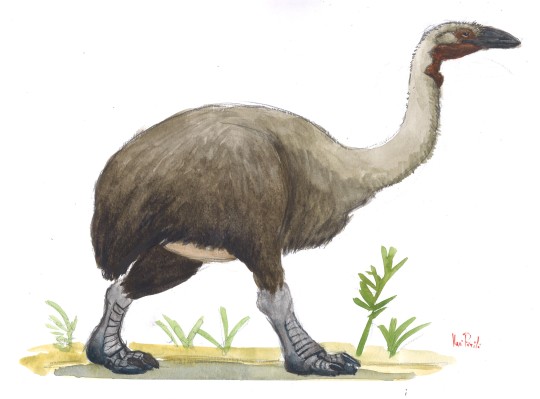

Factfiles:
Vorombe titan

Artwork by @otussketching, written by @zygodactylus
Name Meaning: Titan of the Big Birds
Time: 10,000 years ago to sometime in the past 2000 years (Holocene epoch of the Quaternary period)
Location: Southern Madagascar
Vorombe is a newly erected genus of Elephant Bird, the largest that we know of! Whereas all species of Elephant Bird used to be put in the same genus, distinct differences among the types of Elephant Bird that we know of indicate they deserve their own genus names - and here we are! Vorombe was significantly larger than the other species of Elephant Bird, and probably was about 3 meters (nearly 10 feet) tall when standing. It was also ridiculously heavy, weighing around 650 kilograms. As such, Vorombe is currently the largest known bird ever recorded. It lived in the arid and succulent woodlands as well as the grassland mosaics, the weirdly unique habitats that charactierize Madagascar, and was a major feature in the functioning of those ecosystem - helping to spread plant seeds and maintain habitats as they lived within them. Vorombe and other Elephant Birds lived alongside a lot of weird animals during the Quaternary of Madadgascar, including dwarf hippos, giant tortoises, and giant lemurs.
Note: A paper came out literally on the last day of February this year indicating Vorombe may not be its own genus. More work is needed to determine if this bird is distinct from Aepyornis.
Protodontopteryx ruthae

Artwork by @otussketching, written by @zygodactylus
Name Meaning: Ruth Love’s First Pseudotoothed Bird
Time: 62 million years ago (Danian stage of the Paleocene epoch, Paleogene period)
Location: Mt. Ellen Member, Waipara greensand, Aotearoa
Pseudotoothed birds, the strange fever dream of the Cenozoic, are something of a mystery. They don’t have a clear set of transitional fossils from ancestor to first members. It is uncertain what sorts of modern birds they’re most closely related to. But, luckily, Protodontoperyx helps to put some of the pieces together. The earliest known member of the group - and the smallest - Protodontoperyx seems to have had a wingspan of approximately 1 meter long, much smaller than other Pseudotoothed Birds. It does have the psuedoteeth that characterize the group, indicating they evolved rapidly after the end-Cretaceous extinction. It had much bigger nostrils than later pseudotoothed birds, interestingly enough, indicating it wasn’t quite as adapted to marine life as its later relatives and as such, Protodontoperyx does showcase some interesting transitional anatomy for this group. While later taxa were long-term soaring birds, Protodontopteryx probably lived most similarly to an albatross, selecting targeted prey such as fish and not engaging in long term flights. In its early coastal environment, Protodontopteryx wasn’t alone, but surrounded by other early radiating animals following the extinction - a huge diversity of sharks, but also early penguins and relatives of Mesozoic Neornithine birds that survived into the Cenozoic. As such, Protodontopteryx lived in a weirdly transitional ecosystem, showcasing the rise of Cenozoic Birds as the impact winter began to dissipate at last.
DMM Round One Masterpost
#dmm#dinosaur march madness#dinosaurs#dmm round one#dmm rising stars#paleoblr#paleontology#bracket#march madness#vorombe#protodontopteryx
145 notes
·
View notes
Text
[Paper] East and Southeast Asian hominin dispersal and evolution: A review
Sawafuji et al. reveal new insights into hominin evolution and dispersal in East and Southeast Asia, using ancient DNA and proteomics. #HomininEvolution #EastAsia #SoutheastAsia #AncientDNA #Proteomics
via Quaternary Science Reviews, 01 June 2024: Sawafuji et al. reviews hominin evolution and dispersal in East and Southeast Asia, highlighting new genetic and fossil discoveries. The study discusses assimilation’s role in hominin extinction and the potential of ancient proteomics and sedimentary DNA to uncover historical migration patterns. h/t ISEAA
In recent years, our understanding of the…

View On WordPress
0 notes
Text
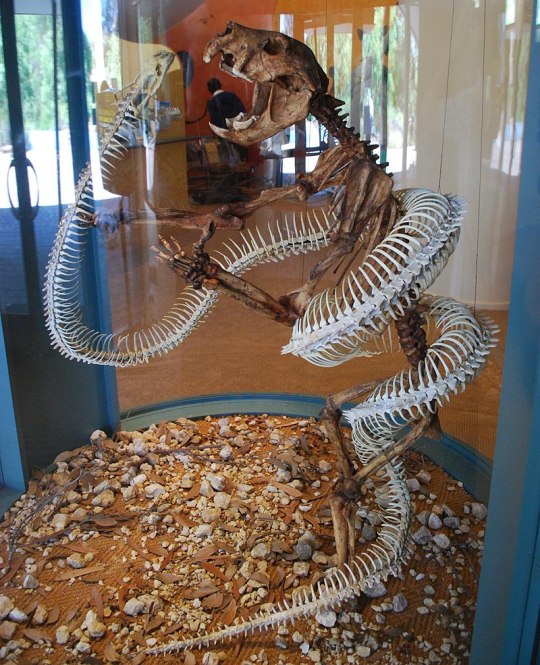



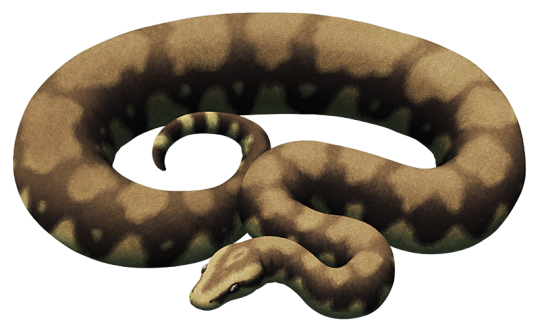
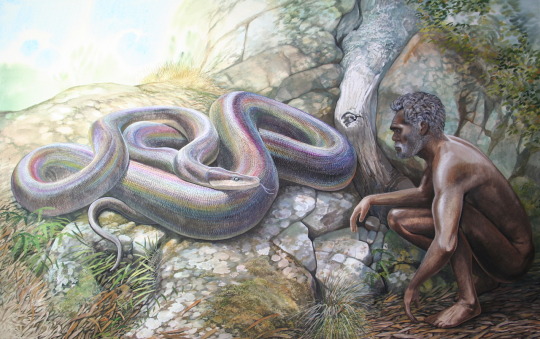
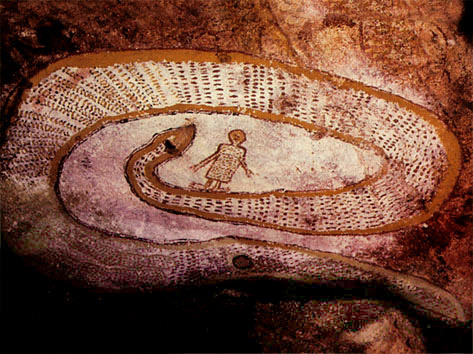
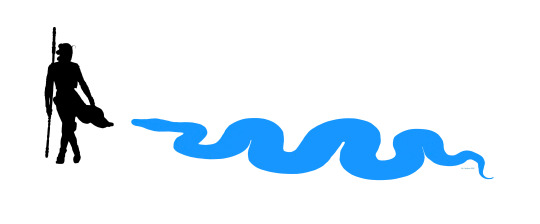

Wonambi is an extinct genus of madtsoiid snakes that lived throughout Australia from the in late Neogene to late Quaternary some 23 million to 50,000 years ago. The first remains of wonambi consisting of a partial skeleton were uncovered in the town of Naracoorte in South Australia. It was given the name Wonambi from the description, by the local Aboriginal people, of a serpent of the Dreamtime. This serpent, a mythological being commonly referred to by both Aboriginal people and Europeans as the Rainbow Serpent, was often held responsible for the creation of major features of the landscape. The family of this genus, Madtsoiidae, became extinct in other parts of the world around 55 million years ago, but continued to thrive on the island continent of Australia where they persisted well into the Pleistocene. There are two known species, Wonambi naracoortensis which reached 12-23ft (4-7m) in length and 100 -300lbs (45- 136kg) in weight, and the smaller Wonambi barriei which reached 6.5 -10ft (2-3m) in length. Although not closely related to pythons, madtsoiids shared a similar way of feeding; slowly suffocating prey before swallowing it whole. However they possessed uniquely robust skulls that were unable to fully disartuculate there jaws like many modern snakes can, which means that even the larger examples of Wonambi would have had to feed fairly small prey. It is believed that wonambi would have inhabited woodlands, grasslands, and scrublands spending its time near creeks and watering holes where it would ambush prey such as wallabies, birds, lizards, kangaroos, and other marsupials which came to drink.
Art used can be found at the following links:

#pleistocene#pleistocene pride#pliestocene pride#pliestocene#ice age#cenozoic#snake#reptile#madtsoiidae#madtosoiid
4 notes
·
View notes
Text

In the year 2424, after the Quaternary glaciation had reshaped the world, the Earth was a blend of the ancient and the hyper-modern. The ice had retreated, leaving behind a landscape both barren and fertile, a blank canvas upon which humanity could reimagine its existence.
Amidst this rebirth, there was Nia, standing as if she had stepped out of a time capsule from the pre-glacial era. Her skin was the rich color of fertile earth untouched by the ice, her dress a tapestry of vibrant red hibiscus flowers, representing the blooming life that had once dominated the tropics. The world had changed, but the essence of life remained, encapsulated in her being.
Nia was not just a symbol of the past; she was the future. She was a creation of the New Dawn - a collective of genetic artists and scientists who had woven her DNA with that of the resilient flora and fauna that had thrived before the glaciers had descended. On her shoulder perched a blue Eos parrot, one of the many avian species that had been brought back from extinction through the wonders of science.
In this new age, humanity had found a balance with nature. Cities were now verdant havens, with skyscrapers cloaked in green and blue, mimicking the forests and oceans that had thrived for eons before human interference. People had learned to live with technology, not just through it, integrating biotechnology into every aspect of their lives to enhance their symbiosis with the planet.
Nia's mission was to be the emissary between the old world's wisdom and the new world's innovations. She communicated with the Sentinels, AI guardians programmed with the core principles of the long-lost tribes and civilizations, keepers of knowledge that predated the ice.
One day, as Nia walked through a garden that had been cultivated to represent the diversity of life, she felt a strange sensation. The earth trembled beneath her feet, and the Eos parrot took flight, its cerulean wings catching the sunlight in a dazzling display. It was a signal - a message from the Sentinels that another change was coming.
The AIs had detected an anomaly beneath the Earth's crust, a remnant from the glaciation period that had the potential to alter the course of the world's climate once again. But this time, humanity was prepared. Nia, with her genetically encoded affinity for the Earth's rhythms, would lead the way in harnessing this energy, using it to sustain the planet rather than destroy it.
With her connection to the past and her embrace of the future, Nia would guide humanity through this second reckoning, ensuring that the beauty of the Earth, reflected in her stunning attire and the vibrant life around her, would endure for eons to come. The Quaternary glaciation had been a test, one that had taught the vital lesson of harmony. Now, with Nia as their guide, the people of Earth were ready to face whatever challenges lay ahead, with the wisdom of history and the tools of the future at their disposal.
1 note
·
View note